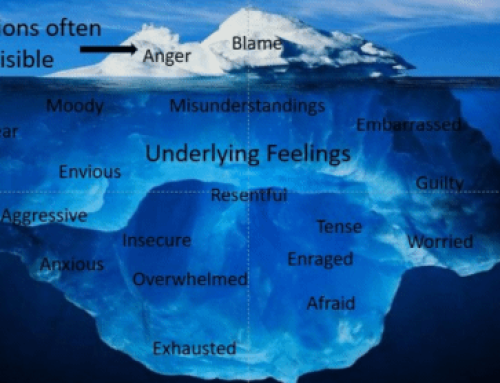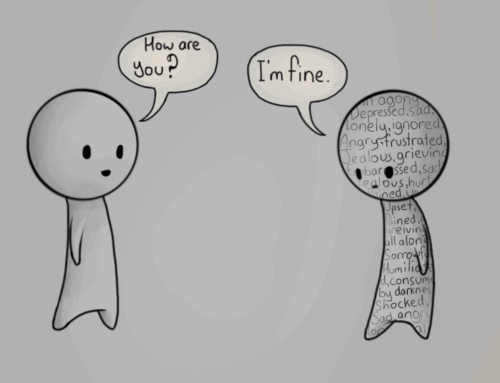How to Know What You’re Feeling (And Talk About It)
August 11, 2015
Categories: Emotion
Sometimes it’s difficult to identify your feelings and talk about them. I think it can be especially tough for men.
I think part of the reason is that some of us just didn’t grow up in environments where people were open about their feelings. Maybe you grew up in a family that talked about mostly superficial things, or was mostly task-oriented. Perhaps it wasn’t okay to express certain feelings, such as sadness, anger, or scare.
But I think that if we want to truly connect with others on a heart level, we need to be able to identify and share our feelings. This kind of talk connects us with others in a deeper way. Talking about the latest baseball game or debating politics just doesn’t do that.
To start, I’d like to give us a language to talk about feelings. Some of my colleagues and I like to use the acronym SASHET to help people identify feelings. SASHET stands for sad, angry, scared, happy, excited, and tender.
Sadness involves feelings of loss. Maybe someone close to you passed away, and you feel loss from that. Maybe you recently got divorced, and there is loss associated with the relationship ending. Maybe you are feeling sad from the loss of a dream, or something you wanted to happen that just didn’t work out. You can sometimes feel sadness as heaviness in your chest. Maybe you feel a lump in your throat. Perhaps you feel like you are about to cry.
Anger involves a boundary being crossed. Maybe someone did something or said something to you or your family that wasn’t right. Maybe you were cheated on a business deal. Maybe you experienced an injustice. You can sometimes feel anger as clenching your fists. Maybe you feel tightness in your jaw. You might feel hot, or amped up.
Scare involves feeling as if you are in danger. Maybe you actually are in physical danger. Or maybe you feel fear about a task at work that you don’t think you can do. Maybe you feel scare about the possibility of a relationship ending, and what that would mean for you and your family. You can sometimes feel fear as butterflies in your stomach. You might feel jittery or shaky. You might have trouble sleeping, or relaxing.
Happiness involves feelings of joy, as if everything is right with the world. Maybe you are feeling sensory pleasure, such as when you take in a beautiful sunset or eat a good meal. Maybe you feel a deep sense of satisfaction from a job well done. You can sometimes feel happiness as a deep restful satisfaction. Maybe you find yourself smiling, or having a more open posture toward the world.
Excitement involves anticipation that something good is going to happen. Maybe you are excited about a new opportunity, such as starting a new school year or beginning a new job. Maybe you are excited about an upcoming trip or vacation. You can sometimes feel excited as having a lot of energy in your body. You might have trouble sitting still, and want to jump up and down.
Tenderness involves deep connection with others. You might feel tender toward someone whom you love and care about. Maybe you were struggling or feeling down, and there was someone there to listen and be with you in your pain. You can sometimes feel tenderness as heaviness in your body or chest. You might experience tears because of your connection with the other person.
Try this exercise the next time you want to connect with someone in a deeper way. Pause for a moment and identify what you are feeling right now. Maybe there is something going on in your body that gives you a clue about what you are feeling. Say to the person you are with, “I feel [pick the feeling that best describes you].” Then give a short context (less than 1 minute) to give the other person a sense of what is going on in your life that might be associated with that feeling. Then have the other person tell you what they are feeling, and give a short context for their feeling.
Action Step: Try doing the feeling exercise with someone close to you (e.g., spouse, child, friend). After working through this exercise, check in with yourself. Do you feel more or less connected to that person?
Related Thoughts
No Comments
Leave A Comment

Subscribe To My Newsletter
Join my mailing list to receive the latest blog posts.
Receive my e-book “The Mental Health Toolkit” for free when you subscribe.






[…] of counseling is called cognitive-behavioral therapy. It’s based on the idea that our thoughts, feelings, and behaviors are all connected and influence one another. For example, if we are feeling sad or […]
[…] can help us identify our needs. When talking about emotions, I like to use the acronym SASHET—sad, angry, scared, happy, excited, and […]
[…] to develop a daily practice of solitude to check in with yourself. What is going on inside you? How are you feeling? What are you wanting? Who are you […]
[…] of the equation. You need to increase your motivation to change, which involves tapping into your emotions. Continuing the health improvement example, what motivates your health goals? What emotions does […]
[…] have a disagreement? Does the person “fight fair?” Do they listen to you? Are they comfortable sharing their feelings (even difficult feelings such as anger and sadness)? Do they support you when you are struggling? […]
[…] Express your feelings. Many people try to stuff or bottle up their feelings. Maybe you were told from a young age that “boys don’t cry.” Or you feel embarrassed about expressing your sadness. Whatever the reason, it’s not a good idea to stuff your feelings. Feelings are the body’s natural way of expressing what is in your heart. Feelings have to be expressed to be worked through. […]
[…] and emotions. Our feelings and emotions can influence our self-efficacy. As we grow up, we tend to associate failure with negative feelings […]
[…] has been a lot of research that has shown connections between our physical body and our emotions. In other words, how we feel physically impacts how we feel emotionally, and how we feel […]